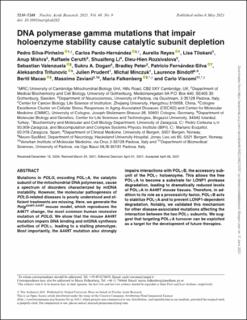| dc.contributor.author | Silva-Pinheiro, Pedro | |
| dc.contributor.author | Pardo-Hernández, Carlos | |
| dc.contributor.author | Reyes, Aurelio | |
| dc.contributor.author | Tilokani, Lisa | |
| dc.contributor.author | Mishra, Anup | |
| dc.contributor.author | Cerutti, Raffaele | |
| dc.contributor.author | Li, Shuaifeng | |
| dc.contributor.author | Rozsivalova, Dieu-Hien | |
| dc.contributor.author | Valenzuela, Sebastian | |
| dc.contributor.author | Dogan, Sukru A. | |
| dc.contributor.author | Peter, Bradley | |
| dc.contributor.author | Fernández-Silva, Patricio | |
| dc.contributor.author | Trifunovic, Aleksandra | |
| dc.contributor.author | Prudent, Julien | |
| dc.contributor.author | Minczuk, Michal | |
| dc.contributor.author | Bindoff, Laurence Albert | |
| dc.contributor.author | Macao, Bertil | |
| dc.contributor.author | Zeviani, Massimo | |
| dc.contributor.author | Falkenberg, Maria | |
| dc.contributor.author | Viscomi, Carlo | |
| dc.date.accessioned | 2021-08-13T11:28:08Z | |
| dc.date.available | 2021-08-13T11:28:08Z | |
| dc.date.created | 2021-06-15T10:26:56Z | |
| dc.date.issued | 2021 | |
| dc.identifier.issn | 0305-1048 | |
| dc.identifier.uri | https://hdl.handle.net/11250/2767773 | |
| dc.description.abstract | Mutations in POLG, encoding POLγA, the catalytic subunit of the mitochondrial DNA polymerase, cause a spectrum of disorders characterized by mtDNA instability. However, the molecular pathogenesis of POLG-related diseases is poorly understood and efficient treatments are missing. Here, we generate the PolgA449T/A449T mouse model, which reproduces the A467T change, the most common human recessive mutation of POLG. We show that the mouse A449T mutation impairs DNA binding and mtDNA synthesis activities of POLγ, leading to a stalling phenotype. Most importantly, the A449T mutation also strongly impairs interactions with POLγB, the accessory subunit of the POLγ holoenzyme. This allows the free POLγA to become a substrate for LONP1 protease degradation, leading to dramatically reduced levels of POLγA in A449T mouse tissues. Therefore, in addition to its role as a processivity factor, POLγB acts to stabilize POLγA and to prevent LONP1-dependent degradation. Notably, we validated this mechanism for other disease-associated mutations affecting the interaction between the two POLγ subunits. We suggest that targeting POLγA turnover can be exploited as a target for the development of future therapies. | en_US |
| dc.language.iso | eng | en_US |
| dc.publisher | Oxford University Press | en_US |
| dc.rights | Navngivelse-Ikkekommersiell 4.0 Internasjonal | * |
| dc.rights.uri | http://creativecommons.org/licenses/by-nc/4.0/deed.no | * |
| dc.title | DNA polymerase gamma mutations that impair holoenzyme stability cause catalytic subunit depletion | en_US |
| dc.type | Journal article | en_US |
| dc.type | Peer reviewed | en_US |
| dc.description.version | publishedVersion | en_US |
| dc.rights.holder | Copyright The Author(s) 2021 | en_US |
| cristin.ispublished | true | |
| cristin.fulltext | original | |
| cristin.qualitycode | 2 | |
| dc.identifier.doi | 10.1093/nar/gkab282 | |
| dc.identifier.cristin | 1915839 | |
| dc.source.journal | Nucleic Acids Research (NAR) | en_US |
| dc.source.pagenumber | 5230-5248 | en_US |
| dc.identifier.citation | Nucleic Acids Research. 2021, 49 (9), 5230-5248. | en_US |
| dc.source.volume | 49 | en_US |
| dc.source.issue | 9 | en_US |

